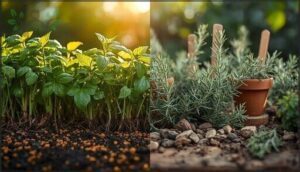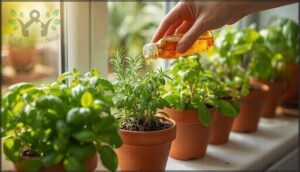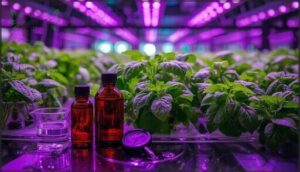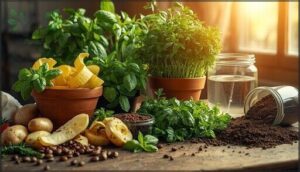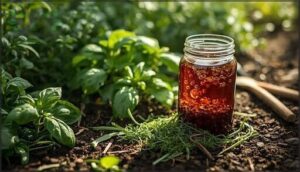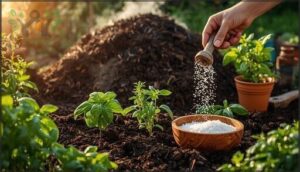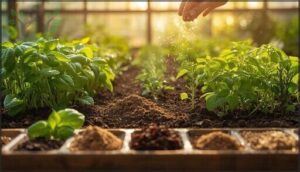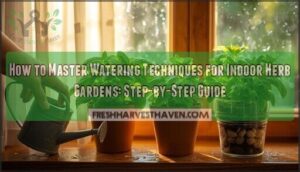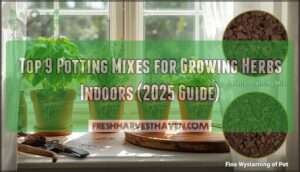This site is supported by our readers. We may earn a commission, at no cost to you, if you purchase through links.
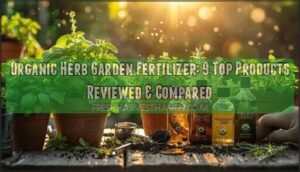
Go with balanced NPK ratios around 5-4-5 or gentle liquid formulas that won’t scorch tender herb roots.
Herbs in containers actually need feeding more often since nutrients leach out every time you water.
Products like Espoma’s liquid plant food and True Organic’s balanced formulations deliver steady nutrition without harsh chemicals that can diminish flavor. Smart fertilizer choices make the difference between surviving herbs and thriving ones that’ll transform your cooking.
Table Of Contents
- Key Takeaways
- Best Organic Fertilizers for Herb Gardens
- 1. Epsoak Epsom Salt for Gardening
- 2. True Organic All Purpose Plant Food
- 3. Miracle-Gro Organics Edibles Plant Food
- 4. Espoma Organic Grow Liquid Plant Food
- 5. Espoma Organic Garden Tone Fertilizer 2 Pack
- 6. Organic Plant Food with Microbes
- 7. Dr Earth Tomato Vegetable Herb Fertilizer
- 8. Organic Plant Magic All Purpose Fertilizer
- 9. True Organic Plant Food Fertilizer
- Key Principles of Organic Herb Fertilization
- Fertilizer Needs for Different Herb Types
- Fertilizing Herbs in Containers and Indoors
- Organic Fertilization for Hydroponic Herb Gardens
- Homemade Organic Fertilizer Solutions
- Maximizing Herb Growth and Flavor Organically
- Frequently Asked Questions (FAQs)
- What is the best natural fertilizer for herbs?
- Can I fertilize herbs during drought conditions?
- How often should I rotate herb fertilizers?
- Which herbs need calcium supplementation for growth?
- Should I fertilize herbs before or after pruning?
- Can over-mature compost harm delicate herb seedlings?
- When should I stop fertilizing herbs before harvest?
- Can organic fertilizers burn delicate herb seedlings?
- How do seasonal changes affect herb fertilization schedules?
- Which organic fertilizers work best for Mediterranean herbs?
- Conclusion
Key Takeaways
- You’ll get the best results by matching fertilizer to your herbs’ growth patterns—fast growers like basil need nitrogen-rich feeding every 2-4 weeks, while Mediterranean herbs like rosemary thrive with minimal, lean fertilization.
- Container herbs require more frequent feeding since nutrients wash out with watering, so you’ll need to fertilize potted herbs every 2-4 weeks with diluted organic solutions to prevent nutrient deficiencies.
- Look for balanced NPK ratios like 5-4-5 or gentle liquid formulas that won’t burn delicate herb roots—products like Espoma’s liquid plant food and True Organic’s formulations deliver steady nutrition without harsh chemicals that diminish flavor.
- You can create effective homemade fertilizers using kitchen scraps, cooking water, and compost tea, which provide the same essential nutrients as commercial products while reducing waste and building healthier soil naturally.
Best Organic Fertilizers for Herb Gardens
When choosing organic fertilizers for your herbs, focus on products that match their specific nutritional needs while building healthier soil over time.
Nine standout options deliver balanced nutrition using natural components like aged compost, living soil microbes, and gentle slow-release nutrients that protect tender herb roots from burning.
1. Epsoak Epsom Salt for Gardening
Your herb garden’s secret weapon might surprise you. Epsoak Epsom Salt delivers 495 mg of magnesium per teaspoon, boosting chlorophyll production and helping plants absorb nutrients more effectively.
Mix 2 tablespoons per gallon of water for a simple foliar spray that enhances photosynthesis. This magnesium sulfate solution works best on sandy, low-pH soils where deficiency testing confirms the need.
You’ll notice greener leaves and improved flavor intensity in your culinary herbs within weeks.
Best For: Home gardeners with herb gardens in sandy or low-pH soil who want to boost plant health naturally without synthetic fertilizers.
- Natural magnesium source that enhances chlorophyll production and nutrient absorption in herbs
- Easy application at 2 tablespoons per gallon creates immediate foliar spray solution
- Low toxicity risk compared to chemical fertilizers with no harmful soil accumulation
- May cause nutrient imbalances if overused on soils that already have adequate magnesium levels
- Can cause leaf scorch when applied at concentrations higher than recommended doses
- Effectiveness remains controversial and requires soil testing to verify actual magnesium deficiency
2. True Organic All Purpose Plant Food
Looking for an all-rounder that won’t break the bank? True Organic All Purpose Plant Food delivers a balanced 5-4-5 NPK ratio with calcium and sulfur that your herbs will love.
You’ll get farm-grade ingredients like seabird guano and fish bone meal—the same stuff commercial organic growers use.
At $7.87 for four pounds, it’s OMRI certified and covers up to 87 square feet. Just apply monthly during the growing season for healthier soil and tastier herbs.
Best For: Budget-conscious gardeners seeking an OMRI-certified organic fertilizer that works for both herbs and vegetables without complex application requirements.
- Farm-grade organic ingredients at an affordable $7.87 price point
- Balanced 5-4-5 NPK ratio with added calcium and sulfur for stronger plants
- OMRI certified and covers up to 87 square feet per bag
- Requires monthly applications throughout the growing season
- Some users report smaller bag size than expected
- Limited dosage instructions for specific plant types or soil conditions
3. Miracle-Gro Organics Edibles Plant Food
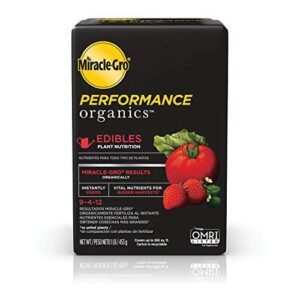
When you’re feeding herbs weekly, this OMRI-certified powerhouse shows results you can see within seven days.
The organic ingredients in Miracle-Gro Performance Organics edibles plant nutrition is specifically formulated for growing tomatoes, vegetables, herbs, and fruits with a balanced 9-4-12 N-P-K ratio.
You’ll cover up to 265 square feet with one pound, making it cost-effective for container and garden herbs alike.
The water-soluble formula dissolves easily, though some gardeners find the earthy smell strong during application.
Best For: Organic gardeners growing edible herbs, vegetables, and fruits who want quick results with OMRI-certified nutrition.
- OMRI-certified organic formula shows visible plant improvements within 7 days
- Balanced 9-4-12 NPK ratio specifically designed for edible plants like herbs, tomatoes, and vegetables
- Cost-effective coverage of up to 265 square feet per pound with easy watering can application
- Strong earthy odor during application that some users find unpleasant
- Can be difficult to dissolve completely in water without agitation or warm water
- Higher price point compared to conventional fertilizers, especially for large garden areas
4. Espoma Organic Grow Liquid Plant Food
Espoma Organic Grow stands out with its balanced 2-2-2 NPK formula that won’t burn your herbs, even if you accidentally double-dose during stressful heat waves.
This liquid concentrate contains kelp extracts and humic acids that boost nutrient uptake while supporting beneficial soil microbes.
Mix 1-2 tablespoons per gallon every 2-4 weeks for healthier stems and deeper green foliage. The Easy Dose cap prevents waste, and one 16-ounce bottle makes up to 32 gallons of plant food for your container gardens.
Best For: Organic gardeners who want a gentle, balanced fertilizer that won’t burn herbs and container plants while supporting beneficial soil microbes.
- Balanced 2-2-2 NPK formula with kelp extracts and humic acids that won’t burn plants even with accidental double-dosing
- Easy Dose cap ensures precise measurements and one 16-ounce bottle makes up to 32 gallons of plant food
- OMRI-certified organic formula is safe around children and pets while supporting beneficial soil microbes
- Strong smell requires outdoor use and takes 2-3 hours to dissipate after application
- Requires dilution with water every 2-4 weeks rather than being a ready-to-use solution
- Lower nutrient concentration compared to synthetic fertilizers may require more frequent applications for heavy feeders
5. Espoma Organic Garden Tone Fertilizer 2 Pack
When you need a granular fertilizer that won’t burn your precious herbs, Espoma’s Garden Tone delivers reliable results. This 3-4-4 formula feeds plants slowly over months, preventing the shock that synthetic fertilizers often cause.
You’ll apply about 1/3 cup per plant monthly, working it into the soil around each herb’s drip line. Bio-tone microbes boost nutrient absorption, while calcium strengthens cell walls for healthier growth.
Best For: Home gardeners growing herbs and vegetables who want organic, slow-release nutrition without the risk of burning delicate plants.
- Slow-release 3-4-4 formula prevents root burn while feeding plants for months
- OMRI-listed organic ingredients with beneficial Bio-tone microbes enhance nutrient absorption
- Easy monthly application with simple granular formula that requires no mixing
- May not be available in local stores, requiring online purchase for many customers
- Lower nutrient concentration means more frequent applications compared to synthetic alternatives
- Price can vary significantly, making cost comparison important before purchasing
6. Organic Plant Food with Microbes
Smart Grower’s microbial fertilizer brings your herb garden’s soil ecosystem back to life. This water-soluble powder packs 2.5×10^8 CFU per gram of beneficial bacteria, including Bacillus velezensis and subtilis.
You’ll see up to 42% better herb yields compared to unfertilized plots, while the microbes boost nutrient availability by 31-48%. The 125-gram bag makes 30 gallons of liquid fertilizer, perfect for container herbs or garden beds.
Though pricey, it’s worth the investment when you’re growing prized basil or expensive saffron.
Best For: Serious herb gardeners and indoor plant enthusiasts who want to maximize yields and improve soil health with science-backed microbial fertilizer.
- Delivers impressive 42% yield increases with beneficial bacteria that enhance nutrient uptake by up to 48%
- Water-soluble powder format makes 30 gallons of liquid fertilizer from one 125-gram bag
- Reduces plant diseases by 22-35% while boosting herb quality and essential oil production
- Higher cost compared to standard organic fertilizers makes it expensive for large-scale applications
- Small bag size limits coverage area and may require frequent reordering for bigger gardens
- Requires proper mixing and application timing to achieve the advertised microbial benefits
7. Dr Earth Tomato Vegetable Herb Fertilizer
Dr. Earth’s powerhouse formula delivers a balanced 4-6-3 NPK ratio, like a perfectly orchestrated meal for your herbs. Fish bone meal, kelp, and feather meal work together with enhanced TruBiotic microbes to breathe life into tired soil.
This OMRI-listed blend feeds plants for months while building drought tolerance. Mix ½ cup per 5-gallon container or 1 cup per 10 square feet of garden space for thriving herbs.
Best For: Organic gardeners growing tomatoes, vegetables, and herbs who want a slow-release fertilizer that builds soil health while delivering consistent nutrition.
- OMRI-certified organic formula with beneficial microbes that improve soil biology and drought tolerance
- Balanced 4-6-3 NPK ratio specifically designed for fruiting plants like tomatoes and herbs
- Long-lasting nutrition that feeds plants for months without risk of burning roots
- More expensive than conventional fertilizers, potentially limiting value for large gardens
- Smaller package size than some users expect for the price point
- May arrive past expiration date based on some customer experiences
8. Organic Plant Magic All Purpose Fertilizer
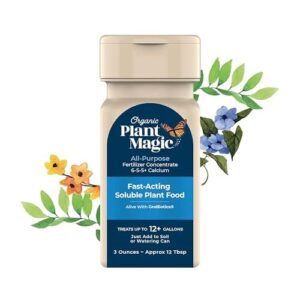
With 55+ trace minerals and beneficial microbes, Organic Plant Magic delivers a balanced 6-5-5 NPK ratio in an easy shaker format. The powder dissolves quickly and won’t burn your plants like synthetic fertilizers.
You’ll see herb yields increase by 28% compared to unfed plants, with markedly improved leaf color and flavor concentration. The formula works well for both indoor and outdoor herbs, though its strong initial smell might catch you off-guard.
Best For: Organic gardeners wanting to boost herb yields and plant health with an easy-to-use, all-natural fertilizer that works indoors and outdoors.
- Increases herb yields by 28% with improved flavor and leaf color through 55 trace minerals and beneficial microbes
- Easy shaker bottle format requires no measuring – just mix 1 tablespoon per gallon of water
- Certified organic and pet-safe with no synthetic chemicals or plant burn risk
- Strong smell when first applied that some users find unpleasant
- Can be messy if spilled and may stain surfaces
- Higher cost per ounce compared to conventional fertilizers
9. True Organic Plant Food Fertilizer
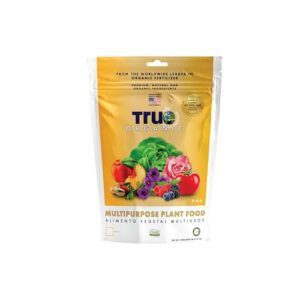
True Organic Plant Food delivers balanced 5-4-5 NPK nutrition that herb gardeners can trust. You’ll get natural ingredients like seabird guano, poultry manure, and shrimp shell meal without synthetic chemicals.
This OMRI-listed fertilizer covers 87 square feet per 4-pound bag, making it cost-effective for most herb gardens.
Apply monthly during the growing season, working 4 tablespoons into the soil for new plantings. It’s pet-friendly and promotes sustained growth through slow-release nutrients.
Best For: Home gardeners seeking an organic, all-purpose fertilizer for herbs, vegetables, and flowers in small to medium-sized gardens.
- OMRI-listed organic certification with natural ingredients like seabird guano and shell meals
- Balanced 5-4-5 NPK formula provides sustained nutrition for diverse plants
- Pet-friendly and chemical-free formulation supports soil health
- Limited coverage area of 87 square feet per 4-pound bag may require multiple purchases for larger gardens
- Monthly applications needed during growing season increases maintenance requirements
- Some users report inconsistent results depending on soil conditions and plant types
Key Principles of Organic Herb Fertilization
Getting the right organic fertilizer for your herbs isn’t about following a rigid formula. Three core principles will guide your choices and help you match what’s in your soil with what your plants actually need.
Understanding these basics means healthy growth without the trial-and-error approach that often leaves new gardeners scratching their heads.
Soil Health and Organic Matter
Healthy soil forms the foundation of any thriving herb garden. Organic matter acts like a sponge, boosting water retention while preventing erosion control issues.
You’ll find that compost benefits extend beyond nutrition—it creates soil biodiversity that encourages nutrient cycling naturally.
When you add organic fertilizers to rich, living soil, you’re improving soil health through proper soil nutrient management.
N-P-K Ratio for Healthy Herbs
Understanding NPK ratios helps you properly feed your herbs. Most herbs do well with balanced ratios like 10-10-10, though fast-growing varieties need extra nitrogen. Keep an eye out for deficiency symptoms and test your soil regularly.
What to watch for:
- Nitrogen deficiency causes yellowing leaves and stunted growth
- Phosphorus shortage leads to purple stems and poor root development
- Potassium lack creates brown leaf edges and weak plants
- Ratio imbalance often shows as nutrient lockout despite fertilizing
- Soil testing reveals best ratios for your specific garden conditions
Importance of Micronutrients
Beyond nitrogen, phosphorus, and potassium, your herbs need micronutrients for best growth. Micronutrient deficiencies can stunt development and reduce flavor intensity. Iron, magnesium, and zinc aid essential plant functions. Soil pH affects nutrient mobility—most herbs prefer slightly alkaline conditions for better absorption. Chelation importance becomes clear when nutrients bind properly to plant roots.
| Micronutrient | Function in Herbs | Deficiency Signs |
|---|---|---|
| Iron | Chlorophyll production | Yellow leaves with green veins |
| Magnesium | Enzyme activation | Leaf yellowing between veins |
| Zinc | Growth regulation | Stunted growth, small leaves |
| Calcium | Cell wall strength | Brown leaf tips |
| Sulfur | Protein synthesis | Overall pale coloring |
Fertilizer Needs for Different Herb Types
You can’t treat all herbs the same for fertilizing, since basil and rosemary have completely different appetites for nutrients. Fast-growing herbs like basil and cilantro need more frequent feeding with nitrogen-rich fertilizers, while slow-growing Mediterranean herbs like thyme and oregano prefer lean soil with minimal fertilization.
Fertilizing Slow-Growing Herbs
Most slow-growing herbs like rosemary and thyme have minimal nutrient needs compared to their fast-growing cousins. You’ll want to focus on root development rather than quick growth spurts.
Here’s your feeding strategy:
- Apply slow-release organic fertilizer once per growing season
- Use half-strength liquid feeds every 6-8 weeks during growing season
- Prioritize soil enrichment with compost over frequent feeding
- Monitor for over-fertilization risks – yellowing leaves signal too much nitrogen
Remember, these herbs prefer lean conditions that mirror their Mediterranean origins.
Fertilizing Fast-Growing Herbs
Fast-growing herbs like basil and cilantro demand more frequent feeding than their slower cousins. You’ll need a nitrogen boost every two weeks during active growth stages. Watch for visual cues – pale leaves signal hunger.
Watering impact matters too, as container herbs lose plant nutrients quickly. Use diluted organic fertilizer to prevent burning while supporting rapid development in your herb garden.
Adjusting Fertilizer for Specific Herbs
Different herbs have unique fertilizer requirements based on their growth patterns and soil composition preferences. Basil thrives with balanced 10-10-10 organic fertilizer every four weeks, while rosemary prefers lighter 4-3-3 ratios to maintain its aromatic oils. Over-fertilizing rosemary can cause it to lose its flavor.
Watch for deficiency symptoms like yellowing leaves in your herb garden—they’re telling you exactly what adjustments your organic gardening routine needs.
Fertilizing Herbs in Containers and Indoors
Container herbs need more frequent feeding than garden plants because nutrients wash out with each watering.
You’ll want to fertilize your potted herbs every 2-4 weeks with diluted organic fertilizer, since their roots can’t search for nutrients like outdoor plants can.
Fertilizer Frequency for Potted Herbs
Container herbs need feeding every 2-4 weeks during growing season, but watering impact and container size matter most. Small pots dry out faster, requiring more frequent fertilizer application than larger containers.
Visual cues like pale leaves signal hungry plants, while herb type determines needs—basil craves more nutrients than rosemary.
Seasonal adjustments mean less feeding in winter for your organic fertilizers.
Preventing Nutrient Washout in Pots
Containers drain faster than garden beds, washing nutrients away with each watering. Choose potting mix with water retention properties and add organic soil amendments like compost to hold nutrients longer.
Use slow-release organic fertilizers that feed plants gradually instead of dissolving quickly. Proper drainage solutions prevent waterlogging while maintaining nutrient content through strategic watering techniques and appropriate container size selection.
Best Practices for Indoor Herb Fertilization
Growing herbs indoors isn’t like tending an outdoor garden. Your basil and rosemary face different challenges when they’re stuck in pots on your windowsill. Getting the feeding and watering right makes all the difference.
- Match fertilizer timing to your container size – smaller pots need feeding every 2-3 weeks
- Adjust organic fertilizers based on light exposure – herbs in bright windows need more nutrients
- Water before fertilizing to prevent root burn and nutrient lockout
- Watch for common issues like yellowing leaves or stunted growth indicating deficiencies
- Use diluted liquid fertilizers rather than granular soil amendments for better control
Organic Fertilization for Hydroponic Herb Gardens
You’ll need specialized liquid fertilizers designed for hydroponic systems since traditional organic fertilizers can clog your equipment and create nutrient imbalances.
Focus on water-soluble organic options that provide complete nutrition, including magnesium, which hydroponic herbs often lack compared to soil-grown plants.
Specialized Fertilizers for Hydroponics
Hydroponic herbs thrive with specialized nutrient solutions that dissolve completely without salt buildup. You’ll need liquid fertilizers designed for soilless systems to maintain proper pH balance and prevent root health issues.
Aeroponics nutrients work differently than soil fertilizers, delivering macronutrients directly to roots. Monitor for nutrient deficiency signs regularly, as hydroponic herb fertilization requires precise plant nutrition management.
The hydroponics nutrients market is projected to reach $3.03 billion by 2030.
Addressing Magnesium Deficiency
When you’re dealing with hydroponic systems, magnesium deficiency symptoms appear as yellowing between leaf veins on older leaves first. This nutritional hiccup often stems from pH issues or nutrient antagonism with calcium and potassium in your herb garden.
- Check soil pH levels between 5.8-6.5 for best magnesium uptake
- Apply Epsom salt fertilizer directly to hydroponic reservoir solutions
- Use foliar magnesium sprays for quick symptom relief
- Reduce calcium and potassium temporarily to prevent nutrient competition
- Monitor organic soil amendments to maintain balanced magnesium levels
Liquid Vs. Granular Fertilizers
When setting up your hydroponic herb garden, you’ll choose between two fertilizer types that work quite differently. Liquid fertilizers get absorbed right away, giving you tight control over what your plants receive. Granular fertilizers take their time, releasing nutrients steadily over weeks or months.
Liquids mean more trips to mix and apply, but your herbs respond fast. Granulars cost less upfront and stick around longer, though you’ll wait longer to see results.
Either path works well for growing healthy, organic herbs—it’s really about matching your schedule and budget to what your garden needs.
| Feature | Liquid Fertilizers | Granular Fertilizers |
|---|---|---|
| Nutrient Release | Immediate absorption | Slow, sustained release |
| Environmental Impact | Higher runoff risk | Lower leaching potential |
| Cost Comparison | Higher per application | More economical long-term |
Homemade Organic Fertilizer Solutions
You can create effective organic fertilizers using common household items like vegetable cooking water, coffee grounds, and eggshells that provide essential nutrients without synthetic chemicals.
These homemade solutions offer the same nitrogen, phosphorus, and potassium that your herbs need while reducing kitchen waste and saving money on commercial products.
Using Kitchen Scraps and Cooking Water
Your kitchen’s leftover scraps and pasta water can transform into organic herb garden fertilizer with minimal effort. Save those potato peels and vegetable trimmings – they’re packed with nutrients your herbs crave.
- Composting kitchen scraps like banana peels and coffee grounds creates nitrogen-rich soil amendments
- Cooking water benefits include minerals from boiled vegetables that boost plant growth naturally
- Application best practices involve cooling water completely before watering and mixing scraps into compost bins
- Waste reduction impact turns household waste into valuable homemade fertilizer while supporting sustainability
Grass Clippings and Weed Tea
Beyond kitchen scraps, grass clippings and weed tea offer powerful nutrient cycling for your organic herb garden fertilizer needs. Fresh clippings decompose quickly, releasing nitrogen as they break down around plants.
Weed tea benefits include concentrated nutrients from steeping weeds in water for weeks. Application methods vary, but always strain liquid before watering herbs.
Safety concerns include avoiding chemically-treated lawns and toxic weeds like poison ivy.
Compost and Epsom Salt Applications
Compost benefits your herb garden by slowly releasing nutrients while improving soil health. You can use Epsom salt as a soil amendment to correct magnesium deficiency in garden beds and compost piles. Here’s how to best use both:
- Apply 1 tablespoon of Epsom salt per square foot of soil for deficiency correction
- Mix compost into soil amendments at a 1: 3 ratio for ideal soil fertility
- Combine Epsom salt with compost piles to speed decomposition
- Use application methods like top-dressing or side-dressing for organic gardening practices
Maximizing Herb Growth and Flavor Organically
You’ll achieve the best herb growth and most intense flavors when you balance soil pH between 6.0-7.0 and provide steady phosphate levels for strong cell development.
Organic methods like compost tea and balanced N-P-K ratios naturally boost essential oil production, giving you that restaurant-quality taste you can’t get from store-bought herbs.
Balancing Soil PH and Nutrient Uptake
Getting your soil pH right unlocks nutrient availability for herbs. Most herbs thrive in slightly acidic to neutral conditions, with an ideal pH range of 6.0-7.0. Monitor soil regularly using simple test kits.
| pH Level | Nutrient Availability | Herb Performance | Organic Amendments |
|---|---|---|---|
| 5.5-6.0 | Limited phosphorus | Stunted growth | Wood ash, lime |
| 6.0-7.0 | Peak uptake | Thriving herbs | Compost, aged manure |
| 7.0-8.0 | Iron deficiency | Yellowing leaves | Sulfur, peat moss |
| 8.0+ | Poor nitrogen access | Weak plants | Organic matter, sulfur |
Organic soil amendments improve soil fertility naturally.
Role of Phosphate in Cell Health
Through both the phosphorus backbone in DNA/RNA structure and cell signaling pathways, phosphate functions drive your herb garden’s health. ATP synthesis powers everything from enzyme activation to root development.
You’ll find phosphorus in bone meal and fish fertilizer – these soil amendments deliver essential building blocks for cellular energy transport.
Enhancing Herb Flavor With Organic Methods
Unlocking your herb garden’s flavor potential starts with understanding the flavor-nutrient link between organic soil amendments and essential oil production.
When you feed the soil microbiome properly with balanced organic fertilizers, you’ll boost terpene enhancement naturally.
Properly balanced organic fertilizers naturally boost terpene production, enhancing your herbs’ essential oils and flavors
Sunlight influence combined with potassium sulfate and Epsom salt creates aromatic herbs that’ll make your neighbors jealous.
Frequently Asked Questions (FAQs)
What is the best natural fertilizer for herbs?
Industry experts report 80% of growers prefer fish emulsion over synthetic options.
Well-aged compost mixed with fish emulsion creates the perfect natural fertilizer for herbs, delivering slow-release nutrients while promoting healthy root development.
Can I fertilize herbs during drought conditions?
Don’t fertilize herbs during drought conditions. Fertilizer encourages growth without adequate water backing, causing additional stress and potentially damaging your plants’ root systems and tissues.
How often should I rotate herb fertilizers?
Don’t put all your eggs in one basket—rotating fertilizer types every 4-6 weeks keeps your herbs healthy.
Switch between compost, liquid, and granular options seasonally to prevent nutrient buildup and soil imbalance.
Which herbs need calcium supplementation for growth?
Most herbs grow well without calcium supplements.
However, oregano, thyme, and parsley benefit from extra calcium since they naturally contain high calcium levels and need proper soil calcium for best growth.
Should I fertilize herbs before or after pruning?
Think of pruning like giving your plants a haircut – they’ll need proper nutrition afterwards.
Feed your herbs after pruning to stimulate vigorous new growth, not before when they can’t use it.
Can over-mature compost harm delicate herb seedlings?
Over-mature compost can burn delicate herb seedlings with excessive nitrogen and salt concentrations. You’ll want to age it longer or mix with regular potting soil for safer application.
When should I stop fertilizing herbs before harvest?
Stop fertilizing one to two weeks before harvesting your herbs. This gives plants time to process nutrients, guaranteeing cleaner flavors and better taste.
Can organic fertilizers burn delicate herb seedlings?
Yes, organic fertilizers can burn delicate seedlings if you apply them too heavily. Dilute liquid organics to quarter-strength and use gentle, slow-release granular types sparingly around young herb plants.
How do seasonal changes affect herb fertilization schedules?
Seasonal changes dramatically shift your fertilization timing. Spring kickstarts growth, requiring weekly feeding. Summer demands twice-weekly nutrition due to heat stress. Fall means scaling back to monthly applications. Winter? Skip fertilizing entirely—herbs rest.
Which organic fertilizers work best for Mediterranean herbs?
You’ll want well-rotted compost or fish emulsion for Mediterranean herbs like rosemary and thyme. These plants prefer nutrient-poor soil and gentle organic feeding that won’t overstimulate growth.
Conclusion
Finding the right organic herb garden fertilizer doesn’t have to break the bank or break your back. You’ve got solid options, from gentle Epsom salt treatments to complete all-purpose blends that’ll keep your basil bouncing and your rosemary strong.
Remember, herbs prefer a light touch—they’re not heavy feeders like tomatoes. Match your fertilizer choice to your growing setup, whether that’s containers on a windowsill or raised beds in your backyard.
With consistent, measured feeding, you’ll harvest flavorful herbs that’ll make your neighbors green with envy.
- https://www.canr.msu.edu/news/ways-organic-fertilizer-improves-culinary-herb-production
- https://fieldreport.caes.uga.edu/publications/C1179/fertilizing-the-home-garden/
- https://growcycle.com/learn/lawn-and-garden/soil-health-and-fertilization/top-organic-fertilizers-for-thriving-vegetable-gardens
- https://arboristnow.com/news/top-10-organic-fertilizer-products-for-home-gardens/
- https://celebratednest.com/what-you-need-to-know-about-fertilizing-herbs/

